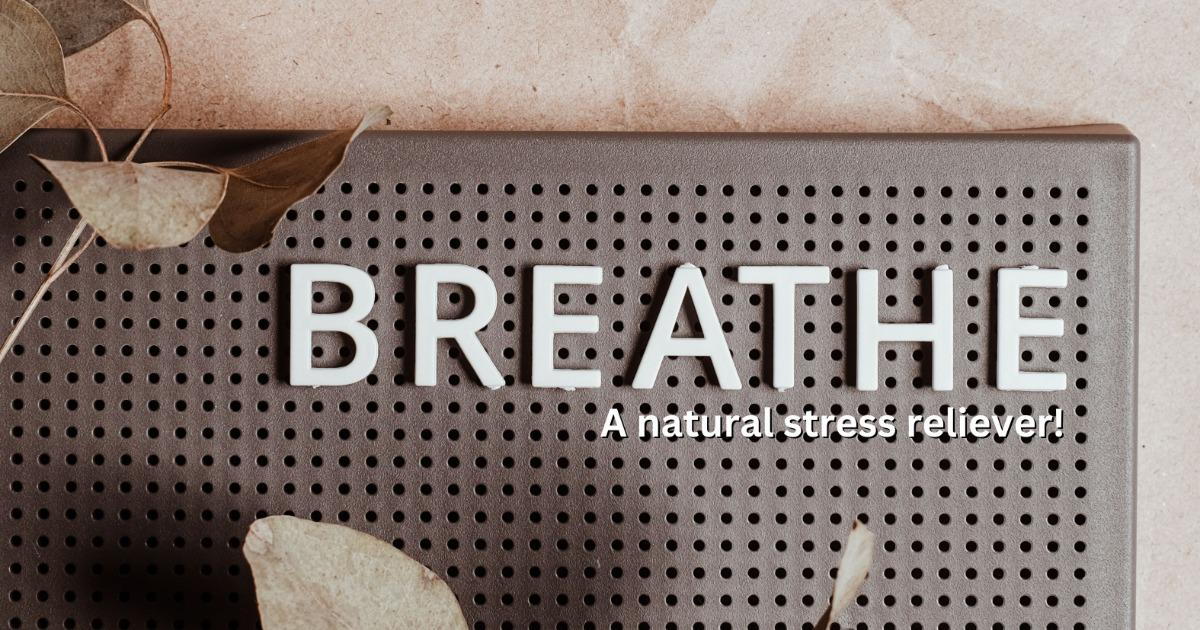Just breathe: A natural stress reliever!

- posted: Oct. 15, 2024
This time of year we find our schedules packed with many different events or activities that we have to coordinate around. I am finding that I am feeling more stress being carried in my shoulders/neck and my breathing changes with that stress as well. We need to be mindful of how our breath affects many different muscles throughout our body. Changing your breath, will also help decrease some of that stress and overall tension.
You are probably familiar with the term “diaphragmatic (or diaphragm) breathing.” This is where you focus on feeling more of your abdomen move with your breath. I want to encourage you to think more about a 360 degree breath. Find a quiet spot to try this:
- Lay on your back with your knees/legs supported for comfort
- Close your eyes and take a few restful breaths
- Now pay attention to where which parts of your body you feel this breath move.
- Do you feel your chest rise up and down
- Do you feel your shoulders, or even your neck muscles moving
- Do you feel more of your abdomen going in and out
- Do you feel this breath into your lower back or pelvis
- Now, take a deep inhale through your nose and see if you can feel that breath all the way into your lower back.
- Exhale your breath through your mouth and try it again.
As your diaphragm lengthens so your lungs can inflate, your pelvic floor and other muscles will relax, allowing the breath to be absorbed throughout your entire body and fill your lungs to their fullest capacity. If we aren’t allowing the diaphragm to lengthen, you’ll feel more tension throughout your neck, shoulders, and even middle back as your lungs are trying to work against your body with that breath. You should feel your ribs expand, your lower back expand, and your abdomen expand (all subtle movements).
I recommend going to a quiet place once a day to work on your breathing. Set a timer for 5 minutes – that’s really all it takes, and you’ll be surprised by how much better your body feels! You might also find that you’re better equipped to manage stressful events with less overall muscle tension.
If you struggle with any of these suggestions, please reach out! We’re here to help you and your body move well so you can live well and feel well.

Dr. Kristin Henry earned her Doctor of Physical Therapy degree from Des Moines University in 2015. She has advanced training in manual therapy and pelvic rehabilitation. She also has experience with patients ranging from pediatrics to geriatrics.

- posted: Oct. 15, 2024
This time of year we find our schedules packed with many different events or activities that we have to coordinate around. I am finding that I am feeling more stress being carried in my shoulders/neck and my breathing changes with that stress as well. We need to be mindful of how our breath affects many different muscles throughout our body. Changing your breath, will also help decrease some of that stress and overall tension.
You are probably familiar with the term “diaphragmatic (or diaphragm) breathing.” This is where you focus on feeling more of your abdomen move with your breath. I want to encourage you to think more about a 360 degree breath. Find a quiet spot to try this:
- Lay on your back with your knees/legs supported for comfort
- Close your eyes and take a few restful breaths
- Now pay attention to where which parts of your body you feel this breath move.
- Do you feel your chest rise up and down
- Do you feel your shoulders, or even your neck muscles moving
- Do you feel more of your abdomen going in and out
- Do you feel this breath into your lower back or pelvis
- Now, take a deep inhale through your nose and see if you can feel that breath all the way into your lower back.
- Exhale your breath through your mouth and try it again.
As your diaphragm lengthens so your lungs can inflate, your pelvic floor and other muscles will relax, allowing the breath to be absorbed throughout your entire body and fill your lungs to their fullest capacity. If we aren’t allowing the diaphragm to lengthen, you’ll feel more tension throughout your neck, shoulders, and even middle back as your lungs are trying to work against your body with that breath. You should feel your ribs expand, your lower back expand, and your abdomen expand (all subtle movements).
I recommend going to a quiet place once a day to work on your breathing. Set a timer for 5 minutes – that’s really all it takes, and you’ll be surprised by how much better your body feels! You might also find that you’re better equipped to manage stressful events with less overall muscle tension.
If you struggle with any of these suggestions, please reach out! We’re here to help you and your body move well so you can live well and feel well.

Dr. Kristin Henry earned her Doctor of Physical Therapy degree from Des Moines University in 2015. She has advanced training in manual therapy and pelvic rehabilitation. She also has experience with patients ranging from pediatrics to geriatrics.
1001 Hudson Rd., Ste. A
Cedar Falls, IA, 50613
